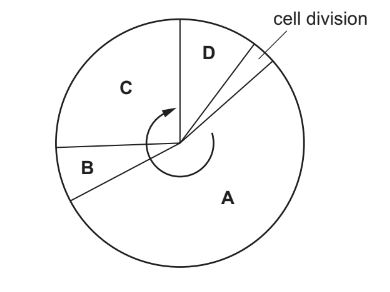Question
Which event is part of the mitotic cell cycle?
A. anaphase
B. cytokinesis
C. DNA replication
D. interphase
▶️Answer/Explanation
Ans:
A
The correct answer is A. anaphase.
The mitotic cell cycle is the process by which cells divide into two identical daughter cells. It consists of several stages, including interphase, prophase, metaphase, anaphase, and telophase/cytokinesis.
Anaphase is the stage of mitosis where the sister chromatids separate and move towards opposite poles of the cell. This is a critical event in mitosis, as it ensures that each daughter cell receives an identical copy of the genetic material.
Cytokinesis is the final stage of the cell cycle, where the cytoplasm divides and two daughter cells are formed. Although cytokinesis is closely associated with mitosis, it is not technically part of the mitotic cell cycle.
DNA replication is a critical event that occurs during interphase, which is the longest stage of the cell cycle. During interphase, the cell grows and replicates its DNA in preparation for mitosis.
Therefore, the correct answer is A. anaphase.
Question
The diagram shows the mitotic cell cycle.
During which phase is DNA replicated?

Answer/Explanation
Answer: B
The division cycle of most eukaryotic cells is divided into four discrete phases: M,G1, S, and G2. M phase (mitosis) is usually followed by cytokinesis.
The S phase of a cell cycle occurs during interphase, before mitosis or meiosis, and is responsible for the synthesis or replication of DNA. In this way, the genetic material of a cell is doubled before it enters mitosis or meiosis, allowing there to be enough DNA to be split into daughter cells.
 Hence, the correct option is B.
Hence, the correct option is B.
Question
Which feature of stem cells enables them to replace cells in tissues such as the skin?
- They are undifferentiated cells that are present at birth.
- They differentiate to form skin cells.
- They divide by mitosis to supply some cells that can differentiate.
- They have the full number of chromosomes.
Answer/Explanation
Ans:
C
Stem cells are undifferentiated cells that have the ability to divide and differentiate into specialized cell types, such as skin cells. They divide by mitosis to produce daughter cells that can either remain as stem cells or differentiate into specialized cells. When a skin cell is damaged or dies, stem cells can divide and differentiate into new skin cells to replace the damaged or dead cells. Therefore, option C, “They divide by mitosis to supply some cells that can differentiate,” is the correct answer as it describes the process by which stem cells can replace cells in tissues such as the skin.
Question
Which statements about the cell cycle are correct?
- The cell cycle consists of both interphase and mitosis.
- DNA replication takes place in interphase.
- A cell can remain in interphase for several months.
A 1, 2 and 3 B 1 and 2 only C 1 and 3 only D 2 and 3 only
Answer/Explanation
Ans:
A
You are correct, A is the correct answer. The cell cycle consists of both interphase and mitosis. DNA replication takes place in interphase. Although the length of interphase varies depending on the cell type, it is typically shorter than several months. Therefore, statement 3 is incorrect.
